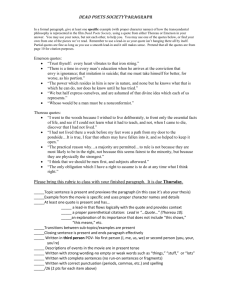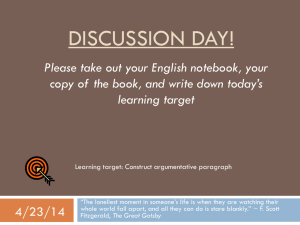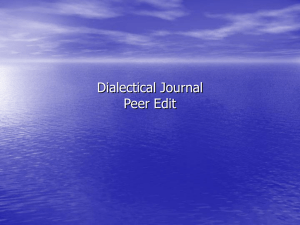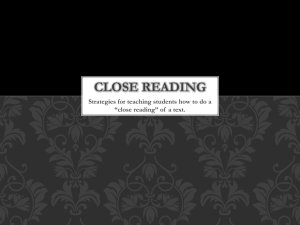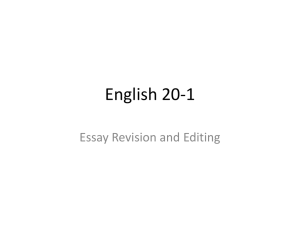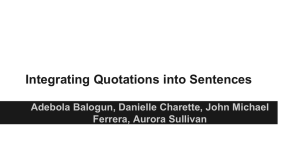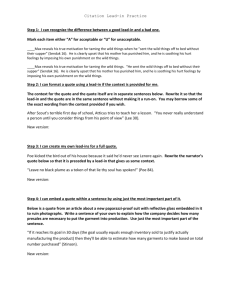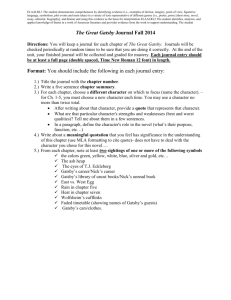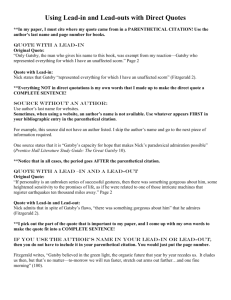PAPEA Paragraph Writing
advertisement
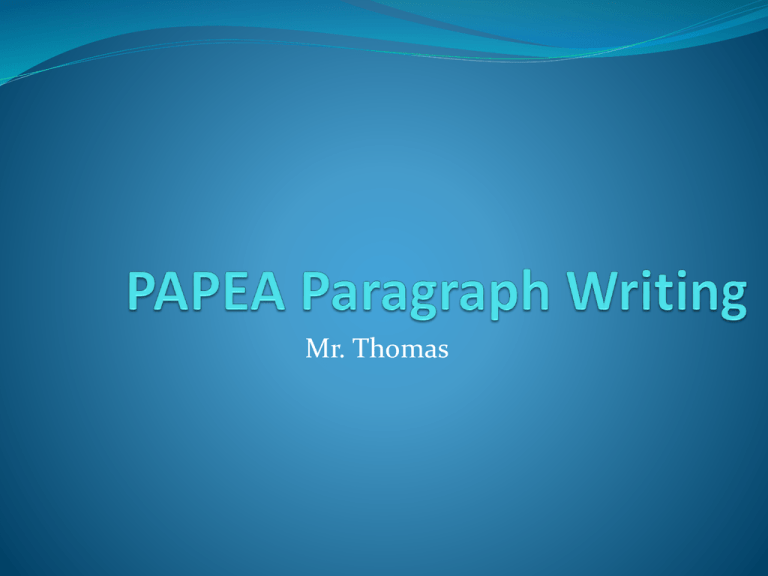
Mr. Thomas P-A-P-E-A Purpose-Audience Point-Evidence-Analysis “P-A” Purpose- why are you writing? To argue, analyze, compare, contrast, summarize, TCAP, college essays, writing directions, lab results, project proposal, process description, etc. Audience- to whom are you writing? College admissions, teachers, editorial, texting friends, letters, emails, forms, etc. It is not part of the paragraph but I would like you to include it at the top of the page! “P-E-A” Point- The position the student makes: The topic sentence of a paragraph, the answer to a question, the main idea of the paragraph, restating the prompt, etc. Evidence- The information needed to prove the point: Examples, results of an experiment, research, data, quotes, equations, facts, observations, etc. Analysis- The HOW and WHY the evidence proves the point: Explain yourself! Show, don’t tell. PAPEA Example: Atticus Finch, one of the characters in the novel, To Kill a Mockingbird is a man of integrity. He defends Tom Robinson, a black man accused of raping a white woman, to the best of his ability, even though this goes against the society. He does it because he believes it is the right thing to do. He tells his children that if he did not defend Tom Robinson, he, "...couldn't hold up my head in this town" (Lee 75). He also refuses to allow the sheriff let his son "off the hook" for killing a man in self-defense. He says, “Heck, if this thing's hushed up, it'll be a simple denial to Jem of the way I've tried to raise him“ (Lee 75). Example continued: People who have integrity are those who do what is right and honest. Atticus does what is right, even though it goes against society. He also insists that his son receives the appropriate punishment and gets no special treatment, because he wants to live honestly and wants to be an example for his son. Clearly, Atticus Finch is a man of integrity. You may also add analysis after each quote instead of all at the end. Paragraph possibilities You may choose one of the lenses to discuss: allegorical, existentialist, biographical. You may choose an important theme to discuss: perseverance: “A man can be destroyed but not defeated,” says the old man after the first shark attack. At the end of the story, is the old man defeated? Why or why not? Nature: What role does the sea/ nature play in OMAS? An actual question from an Advanced Placement Exam: The central character in a novel or a play often encounters moral, physical, or psychological danger. Select an important character and show how the danger(s) a character faces reveals character, and how that revelation relates to the structure and/or meaning of the work. The use of literary elements: symbol, simile, personification, Imagery, Hubris and how it affects the reader/work Anything else you might want to focus on as long as it is focused and clear and supportable. You will need at least three quotes to support ( evidence) Format for Citations in text “The line you want to use from the text” (Last name of author page). “The line you want to use from the text?” (Last name of author page) “The line you want to use from the text!” (Last name of author page) Example: “Everything was immense.” (Blake 1). No comma, period, pg. or ANYTHING other that author and a number. No comma, no period, no pg. It is acceptable that if the author doesn’t change you can just use the page number. Ex: “” (Blake 7) “” (46) “” (3) If you are working with more that one author, you must add author each time it changes. Ex: (Hemingway 121) “” ( 14) “” ( Steinbeck 215) “” (156) “” ( Hemingway 212) Quote Lead-ins Now we need to work on lead-ins! What do you need in a quote lead-in? There are two elements to a quote lead in: Speaker of the quote (even if it is the narrator) Context of the quote (place, situation, who are they speaking to, why are they speaking) Why do you need a lead in? To help explain the quote To avoid having a “hanging quote” To lead into analysis To set up the quote for the reader who may not have read the novel To help with transitioning throughout the essay To show what you know about the quote Steps to follow for the lead-in List these for each quote you used for your citation practice Speaker Context Quote- Author and page number of quote Examples from The Great Gatsby Speaker: Gatsby Context: Gatsby’s second party in the novel where Daisy and Tom are there and have just left and Nick and Gatsby are discussing Daisy’s demeanor when she left. Page: 116 Quote: “Can’t repeat the past? Why of course you can!” Examples of the lead-in As Gatsby is trying to hang on to his dream of he and Daisy being together he claims in response to Nick, “Can’t repeat the past? Why of course you can!” (Fitzgerald 116) Practice Use each of the quotes you cited correctly for this practice For each of the quotes you now need to add a quality lead-in using speaker and context! Be sure to have cited these quotes correctly.
